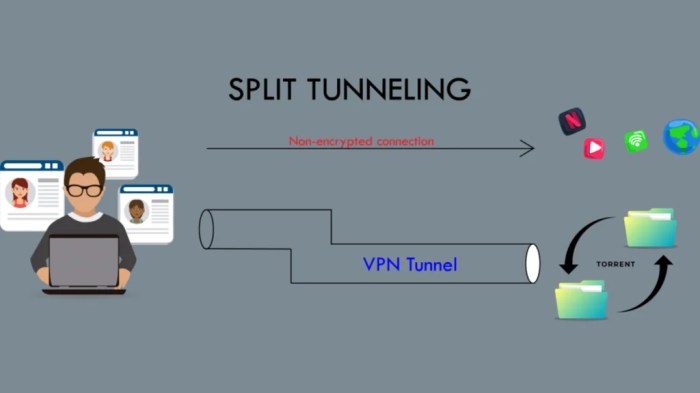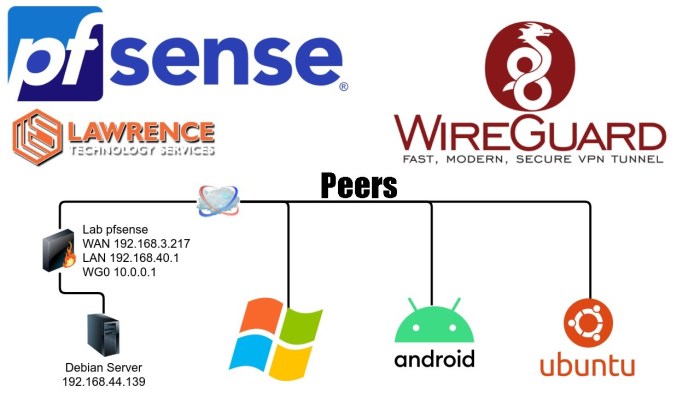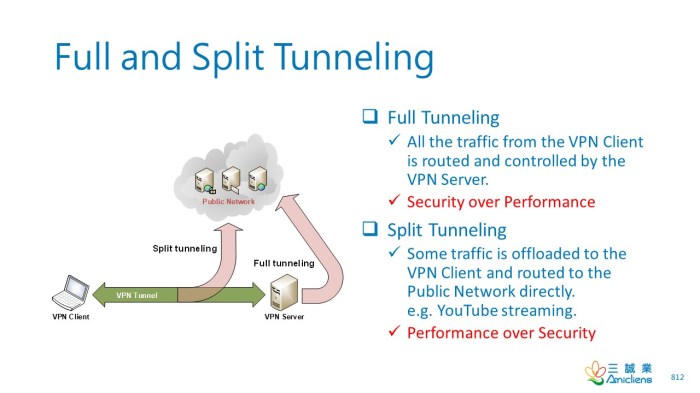In the realm of secure networking, WireGuard has emerged as a game-changer. This cutting-edge VPN technology offers unparalleled speed and security, making it a favorite among privacy-conscious users. However, understanding the nuances of WireGuard’s full tunnel and split tunnel configurations is crucial for maximizing its benefits.
This comprehensive guide will delve into the advantages and disadvantages of each configuration, providing you with the knowledge to make an informed decision for your specific needs. Whether you’re a security enthusiast, a network administrator, or simply seeking to enhance your online privacy, this exploration will equip you with the insights you need.
Define WireGuard Full Tunnel and Split Tunnel

WireGuard is a modern, open-source VPN protocol that offers high speed, security, and simplicity. It establishes an encrypted tunnel between two devices, allowing secure data transmission over the internet. WireGuard configurations can be categorized into two types: full tunnel and split tunnel.
Full Tunnel
In a full tunnel configuration, all internet traffic from the client device is routed through the VPN tunnel. This means that all online activities, including browsing, streaming, and gaming, are protected by the VPN encryption. Full tunnels provide comprehensive privacy and security, as all data is concealed from internet service providers (ISPs), hackers, and other potential eavesdroppers.
Split Tunnel
Unlike full tunnels, split tunnels allow specific traffic to bypass the VPN tunnel and access the internet directly. This is useful for optimizing performance and reducing latency for certain applications or services. For example, you may choose to exclude local network traffic or real-time applications from the VPN tunnel to improve their speed and responsiveness.
Split tunnels offer a balance between security and performance, allowing you to protect sensitive data while maintaining optimal internet connectivity for other activities.
Advantages of WireGuard Full Tunnel
WireGuard full tunneling offers robust security benefits, safeguarding all network traffic that traverses the VPN connection. This comprehensive protection ensures that sensitive data and online activities remain private and secure, regardless of the network or device used.
Enhanced Security
Full tunneling encrypts all data packets, including those destined for local network resources. This prevents eavesdropping, data interception, and unauthorized access to sensitive information, even on public Wi-Fi networks.
Protection from Malware and Phishing
Full tunneling blocks malicious traffic and phishing attempts by filtering all incoming and outgoing data. This additional layer of protection helps prevent malware infections, data breaches, and financial losses.
Privacy on All Networks
Full tunneling ensures privacy on all networks, regardless of their security or trustworthiness. It conceals user IP addresses and online activities from ISPs, network administrators, and potential attackers.
Suitable Scenarios
Full tunneling is particularly advantageous in scenarios where:
- Strong security is paramount, such as in corporate networks or when handling sensitive data.
- Users frequently connect to untrusted or public Wi-Fi networks.
- Remote workers require secure access to corporate resources from anywhere.
Disadvantages of WireGuard Full Tunnel
Full tunneling offers comprehensive security but also comes with potential drawbacks.
Performance and Resource Consumption
Full tunneling encrypts all network traffic, which can impact performance, especially on low-bandwidth connections. Additionally, the encryption process consumes more CPU and memory resources, which may not be ideal for resource-constrained devices.
Unsuitable for Split Tunneling Scenarios
In scenarios where only specific applications or traffic need to be routed through the VPN, full tunneling is not suitable. Split tunneling allows selective routing of traffic, while full tunneling routes all traffic through the VPN, which may not be desirable or necessary in certain use cases.
Advantages of WireGuard Split Tunnel
WireGuard split tunneling offers several advantages that make it a preferred choice in specific scenarios. One of its primary benefits is the ability to selectively route traffic. This means that you can choose which traffic goes through the VPN tunnel and which traffic remains on your local network.
Enhanced Security and Privacy
Split tunneling allows you to route sensitive traffic, such as online banking or work-related communications, through the VPN tunnel, while allowing other traffic, such as streaming or gaming, to bypass the tunnel. This provides an extra layer of security and privacy for your sensitive data without compromising the performance of your other online activities.
Optimized Performance
By selectively routing traffic, split tunneling can improve the performance of your VPN connection. Since only a portion of your traffic is encrypted and routed through the VPN tunnel, the overall bandwidth consumption is reduced, resulting in faster speeds and lower latency.
This is particularly beneficial for activities that require high bandwidth, such as video conferencing or online gaming.
Access to Local Resources
Split tunneling allows you to access local network resources, such as printers or shared files, even when you are connected to the VPN. This is useful in scenarios where you need to access both internal and external resources simultaneously, such as when working remotely and needing to access company resources while also being able to print documents locally.
Flexibility and Control
Split tunneling provides greater flexibility and control over your VPN connection. You can customize the routing rules to suit your specific needs and preferences. For example, you can create rules to route all traffic from a specific application or website through the VPN tunnel, while allowing all other traffic to bypass the tunnel.
Disadvantages of WireGuard Split Tunnel
WireGuard split tunneling, while providing flexibility, also introduces certain drawbacks. Understanding these limitations helps in making informed decisions about network configurations.
Security Implications of Selective Routing
Split tunneling selectively routes traffic, potentially compromising security. By allowing certain traffic to bypass the VPN, it creates a potential entry point for attackers to access the unprotected network. This is especially concerning for sensitive data or applications that require robust protection.
Suitability Concerns
Split tunneling may not be suitable for all scenarios. For example, in highly regulated environments or organizations with strict security policies, full tunneling is often preferred to ensure comprehensive protection of all network traffic. Additionally, split tunneling can complicate network troubleshooting and management, as traffic flow becomes more complex and difficult to monitor.
Comparison of WireGuard Full Tunnel vs Split Tunnel
WireGuard is a modern VPN protocol that provides robust security and high performance. It offers two main configurations: full tunnel and split tunnel. Understanding the key differences between these configurations is crucial for choosing the most suitable option for your specific needs.
Key Features and Benefits
| Feature | Full Tunnel | Split Tunnel |
|---|---|---|
| Security | All internet traffic is encrypted and routed through the VPN tunnel, providing comprehensive protection against eavesdropping and man-in-the-middle attacks. | Only selected traffic is routed through the VPN tunnel, leaving other traffic unprotected. |
| Performance | Can introduce a slight performance overhead due to encrypting all traffic. | Typically provides better performance as only a portion of traffic is encrypted. |
| Flexibility | Provides consistent security regardless of network configuration. | Allows for selective routing of traffic, offering greater flexibility in managing network resources. |
Factors to Consider When Choosing Between Full Tunnel and Split Tunnel
When choosing between full tunnel and split tunnel, consider the following factors:
Security Needs
Full tunneling provides the highest level of security by encrypting all traffic, regardless of destination. This is ideal for highly sensitive environments where data protection is paramount. Split tunneling, on the other hand, only encrypts traffic destined for specific networks, leaving other traffic unencrypted.
This can be less secure but may be necessary for applications that require direct access to local resources.
Network Requirements
Full tunneling can impact network performance due to the encryption overhead. This may not be an issue for high-bandwidth networks, but it can be a concern for slower connections. Split tunneling can mitigate this impact by only encrypting traffic destined for specific networks.
Performance Considerations
Split tunneling can improve performance by reducing the amount of traffic that needs to be encrypted. This can be beneficial for applications that are latency-sensitive or require high bandwidth. However, split tunneling can introduce additional complexity in managing network traffic.
Case Studies

In this section, we will delve into real-world examples of WireGuard deployments utilizing both full and split tunneling. We will explore the challenges and benefits encountered in each scenario, providing valuable insights into their practical applications.
Full Tunnel Deployment
In a full tunnel deployment, all internet traffic is routed through the VPN tunnel. This approach offers comprehensive security and privacy, as all data is encrypted and protected from eavesdropping and other threats.
Benefits:
- Enhanced security and privacy: Full tunneling ensures that all internet traffic is protected by the VPN encryption, minimizing the risk of data breaches or unauthorized access.
- Simplified network management: With all traffic routed through the VPN, network administrators can easily control and monitor access to internal resources and enforce security policies.
Challenges:
- Performance impact: Full tunneling can introduce latency and reduce network performance, especially for bandwidth-intensive applications or connections with limited bandwidth.
- Limited access to local resources: When using full tunneling, users may not be able to access local resources, such as printers or network-attached storage devices, without additional configuration.
Split Tunnel Deployment
In a split tunnel deployment, only specific traffic is routed through the VPN tunnel, while other traffic is sent directly over the local network. This approach allows users to access local resources and enjoy better performance for certain applications.
Benefits:
- Improved performance: Split tunneling allows for selective routing of traffic, enabling users to prioritize performance for certain applications or websites while maintaining VPN protection for sensitive data.
- Access to local resources: With split tunneling, users can easily access local resources, such as printers or network-attached storage devices, without having to configure additional settings.
Challenges:
- Security concerns: Split tunneling introduces a potential security risk, as some traffic may not be protected by the VPN encryption. This can be a concern for organizations handling sensitive data.
- Complex configuration: Split tunneling requires careful configuration to ensure that only the desired traffic is routed through the VPN tunnel. Misconfigurations can lead to security vulnerabilities or performance issues.
Best Practices for WireGuard Full Tunnel and Split Tunnel Configurations
When setting up and managing WireGuard tunnels, it is crucial to adhere to best practices to ensure optimal performance, security, and reliability. These best practices encompass various aspects, including configuration settings, security measures, troubleshooting, and monitoring.
Optimal Configuration Settings
To achieve optimal performance, it is essential to configure WireGuard tunnels with appropriate settings. This includes:
-
- -*Selecting the appropriate encryption algorithm
WireGuard supports a range of encryption algorithms, including ChaCha20, AES-GCM, and Blake2s. The choice of algorithm should be based on the desired level of security and performance.
- -*Selecting the appropriate encryption algorithm
-*Choosing the right port
The default port for WireGuard is 51820, but it is advisable to change it to a non-standard port to enhance security.
-*Setting the correct MTU
The maximum transmission unit (MTU) should be adjusted according to the network environment to avoid fragmentation and improve performance.
Security Measures
Security is paramount when using WireGuard tunnels. Best practices include:
-
- -*Using strong passwords
Strong passwords are essential for protecting the private key used to establish the WireGuard connection.
- -*Using strong passwords
-*Implementing two-factor authentication (2FA)
2FA adds an extra layer of security by requiring a second form of authentication, such as a code sent to a mobile device.
-*Regularly updating WireGuard software
Keeping WireGuard software up to date ensures that the latest security patches and fixes are applied.
Troubleshooting and Monitoring
To ensure the smooth operation of WireGuard tunnels, regular troubleshooting and monitoring are crucial. Best practices include:
-
- -*Using a VPN monitoring tool
A VPN monitoring tool can provide real-time visibility into the status of WireGuard tunnels, allowing for quick identification and resolution of issues.
- -*Using a VPN monitoring tool
-*Checking logs
WireGuard generates logs that can be useful for troubleshooting connection problems.
-*Testing connectivity regularly
Regularly testing the connectivity of WireGuard tunnels helps to identify any potential issues before they become a problem.
Future Trends in WireGuard Full Tunnel and Split Tunnel
The future of WireGuard holds exciting advancements that will shape the landscape of VPN technology.
As the protocol continues to mature, we can expect to see significant improvements in performance, security, and flexibility.
Potential Advancements in WireGuard Technology
* Improved encryption algorithms: WireGuard’s current encryption algorithm, ChaCha20, is already highly secure, but future versions may incorporate even stronger algorithms, such as AES-256-GCM, to enhance data protection.
Optimized routing protocols
WireGuard’s routing protocol, Babel, is efficient and reliable, but future iterations may introduce additional optimizations to improve network performance and reduce latency.
Enhanced support for mobile devices
WireGuard is already well-suited for mobile devices, but future versions may include dedicated optimizations for mobile operating systems, such as improved battery life and seamless connectivity.
Impact on Full and Split Tunneling
These advancements will have a profound impact on the use of full and split tunneling. Full tunneling will benefit from improved encryption and routing, making it even more secure and efficient for protecting all network traffic. Split tunneling, on the other hand, will gain flexibility and convenience with enhanced support for mobile devices.
Speculation on the Future of WireGuard Tunneling
As WireGuard continues to evolve, we can speculate on the future of tunneling. It is possible that WireGuard may become the de facto standard for VPNs, replacing older protocols like OpenVPN and IPsec. Additionally, WireGuard’s open-source nature and community support suggest that it will remain a vibrant and innovative project, with ongoing development and enhancements.
Summary

Ultimately, the choice between WireGuard full tunnel and split tunnel depends on your unique requirements. If security is paramount, full tunneling offers the most robust protection. However, if flexibility and selective routing are essential, split tunneling provides a more tailored approach.
By understanding the strengths and limitations of each configuration, you can optimize your WireGuard deployment to achieve the ideal balance of security, performance, and convenience.